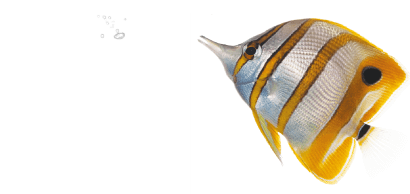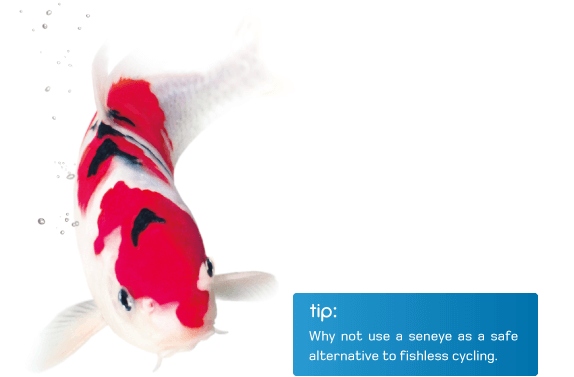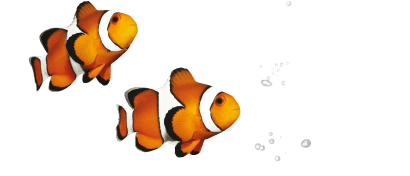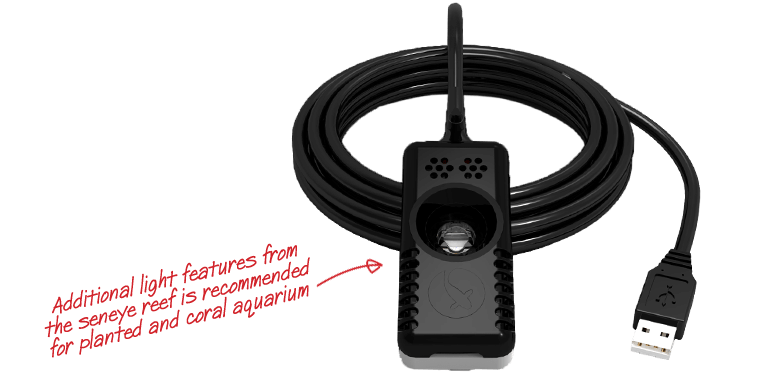why use seneye to monitor your aquarium?
We buy a fish tank to hold water, then a heater or chiller to keep the temperature constant, filters to keep the fish from becoming poisoned, along with lights for illumination and plant growth. Then we spend a fortune on fish, coral, plants and décor which we become very attached to. The next step is to cross our fingers and hope for the best or spend half our lives testing and checking is all okay. There is an alternative, let seneye protect your loved ones.

All parameters are monitored - not only ammonia
No aquarium or pond, however mature, can be guaranteed as stable and never to crash. Changes in water parameters are bad and can affect aquarists from novice to professional. A range of things from poor aquarium husbandry to equipment failure can cause swings in water parameters that harm your fish. A seneye constantly watches for these dangerous changes which are undetectable to the human eye. Seneye monitors parameters which are key to the survival of aquatic life and likely to change very fast when something does go wrong.
-

temp
Temperature is one of the most important environmental factors in the aquatic environment. Aquarists keep fish from all over the world and they can have very different temperature requirements. Pond temperature can swing greatly and this can have a major effect on fish, metabolic rates, biological filter activity and oxygenation. Often heaters and chillers are used to control temperature but no matter how expensive your equipment is it will eventually stop working; when it does you will wish you had a warning device to let you know things weren’t right.

-

pH
pH in an aquarium or pond is very important to understand as many fish will only thrive within a certain range. Even though fish are good at adjusting to pH levels over time, sudden changes can kill. For this reason, watching for change and understanding fluctuations is very important, as is understanding the potential difference in water chemistry when introducing new fish. pH will constantly change in any aquarium, so taking a reading once a week or month may not show you what the real pH is. Constantly taking pH readings is the only way to understand the natural cycles in your aquarium and protect it from the few times it will crash.
-

NH3
All fish excrete ammonia as a waste product and if it builds up in aquarium water it will quickly become toxic. Free ammonia (NH3) is a toxic gas and is the number 1 killer of fish. NH3 should not be confused with non toxic ammonium (NH4). Traditional ammonia test kits measure NH4 and until now people have not been able to monitor NH3 at the low levels that are toxic. Normally aquarium filters are designed to convert or remove NH3 & NH4 through biological activity or chemical absorption. Rarely tested for in mature aquariums, NH3 is viewed as a ‘new tank’ issue; the reality is any aquarium can experience a rise in toxic NH3 through pH change, filter blockages, bacteria crashes (sometimes by unseen insecticides), chemicals additives, or even simple water changes. If you wouldn’t dream of keeping fish without a filter, you should invest in making sure it’s working.


-

water level
Without water fish don’t do too well. If a filter tube becomes disconnected or a leak occurs the water level can drop very quickly. The Seneye is intelligent enough to know if it is in or out of water, so no false readings and you have the option to secure it somewhere the level is important and see online if the level drops.

-

light
In an aquarium, light is one of the most important factors in the growth rate of plants and coral. But how do you know if you have the right type and amount of light? The enhanced features of the seneye reef help the advanced aquarist understand more by giving you PAR, LUX, Kelvin and spectra; to compare models click here. Even if you only have a seneye home or pond you can still see light level compared to previous days and other parameters. In a pond, the seasonal variation in the strength and duration of light can influence water temperature as well as algae (green water). One cool thing you can do with the seneye reef is save your light information with labels. Using this will allow you to see differences in light across the aquarium and when artificial aquarium light sources start to reduce in output, compromising growth. If you don't have a reef, don't worry, you can upgrade.
-

PAR
Photosynthetic Active Radiation is a measurement of light that is used for photosynthesis. Photosynthesis is a process where cells called chlorophyll convert light, carbon dioxide and water into oxygen and sugar. These sugars provide building blocks for all plant and coral life. Ensuring a photosynthetic organism has the right amount and type of light is essential to keeping them healthy.
-

LUX
LUX is a more common measurement of light and included to allow people who are used to working with it for comparison. It has traditionally been used to establish the quantity of light in conjunction with kelvin to understand spectral output (quality).

-

kelvin
Daylight has a full spectrum of wavelengths (colours) that create white light. Slight variations on the blue and red levels give us different Kelvin levels. Traditionally, Kelvin (K) has been used to indicate the suitability of a light source for a specific biotope. This is because different biotopes and organisms have different spectral requirements. We should view Kelvin and spectra as a separate issue to the quantity of light (or light power, PAR, LUX). We should look at spectra as a measurement of quality or fit for purpose for that specific biotope. As a rule, freshwater lamps have a lower Kelvin 6500K (redder) and marine lamps have a higher Kelvin 15000K (bluer).
-

spectrum analyser
With artificial light, a selection of colours or even a single colour (especially LED’s) can be used to illuminate an aquarium and because of this they don't always have a Kelvin. The spectrum analyser allows us to compare RGB levels on a simple graph. The graph has a PAR overlay function so you can see how it fits. It is a useful tool that helps to overcome some of the limitations of kelvin. To learn more about lighting in the aquarium click here.